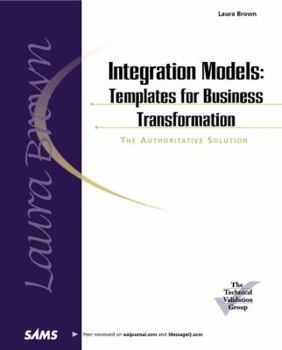Integration Models: Templates for Business Transformation: The Authoritative Solution
PLEASE PROVIDE COURSE INFORMATION PLEASE PROVIDE This description may be from another edition of this product.
Format:Paperback
Language:English
ISBN:067232055X
ISBN13:9780672320552
Release Date:January 2000
Publisher:Sams
Length:352 Pages
Weight:1.32 lbs.
Dimensions:0.8" x 7.4" x 9.1"
Customer Reviews
2 ratings
Acquired or acquiring? If so, you *need* this book
Published by Thriftbooks.com User , 22 years ago
I read this book because it was strongly recommended by a friend whose advice turned out to be invaluable. The approach that Ms. Brown takes is one of the most practical, straightforward I have come across. If followed it will reduce technical, cost and schedule risks that are rampant in application integrations, especially those to which this book targets: gluing together systems that have been separately developed by two organizations and now have to be merged into a coherent whole when one of the organizations acquires the other. The seven models proposed each address a unique requirement or situation based on a pattern. That Ms. Brown has managed to distill integration challenges into seven models is an impressive feat. It shows the level and depth of her experience, and from what I read in the book, combined with my own experience, she has completely thought this through.One of the most important aspects of this book is that it's balanced between both business and technical considerations, and also embodies the best project management practices. As someone who takes applications into production and provides support I think that the overall approach set forth in this book also strikes a good balance between integration activities and post-integration support. It's refreshing to find a book that accomplishes this.This is an important book that serves two purposes: it is a solid collection of application integration models that should be in the toolbox of all IT/IS professionals whose job entails enterprise architectures or application integration, and it is a clear roadmap for those folks who have just been told that their company just acquired another and the systems need to be integrated into a coherent whole without disruption the business operations of either organizational unit. It serves both purposes exceptionally well. Bravo Ms. Brown!
One of the most important books on EAI published this year
Published by Thriftbooks.com User , 22 years ago
Ms. Brown has given us a gift: a book that thoroughly describes the challenges of implementing integrated enterprise applications, and how to overcome those challenges using proven methods that address both business and technical issues. This book is divided into four parts: (I) Techniques, (II) Catalog of Integration Models, (III) Applying Integration Models and (IV) Appendices.The three chapters that comprise Part I sets the context for EAI, introduces integration models (which are, in essence, patterns) and discusses the environment for integration modeling. I liked this part for the following reasons: it focuses on business imperatives, and includes risk factors from a company and industry perspective; it bridges both business and technical views, and provides a frank discussion of the challenges faced by the implementation team. One of the highlights of part I is the approach to selecting a project approach and advice on placing project deliverables in context.Part II is a catalog of integration models that contains seven chapters, each devoted to a specific model template. The templates are provided in a fixed format is closely aligned to Design Patterns (by Gamma, et al), making selection of the appropriate model for your organization or project straightforward. The format is: Description, Discussion, When the Template Applies, Examples, Benefits and Consequences, Realization, EAI Applications to which it applies, and Templates that work well with the one discussed. The seven integration models for which templates are provided are: Cycle, Seed, Web, Flow, Wave, Ring, Cell and Tree. I thought it was interesting how the templates themselves could be classified by geometric shape, but as you read through them it makes sense. Moreover, you begin to look at the integration models in a different way, which in turn, triggers creative thoughts. The author intersperses case studies and technical discussions in Part III, Applying Integration Models. The case studies are: Chapter 12-Enterprise Resource Planning and Chapter 15 - Integration in Telecommunications; technical discussions include: Chapter 13-Using Integration Models to Synthesize Industry Models and Chapter 14-Data Strategy, Warehousing, and Architecture with Integration Models. The case studies and technical discussions not only added a dimension of credibility to Parts I and II, but reinforced one another. Sample artifacts included in Appendix B are valuable. I especially like the checklist of factors that indicate an increased need for integration, but the sample letters, and other documents are also useful.This book is to implementing enterprise applications what David Linthicum's Enterprise Application Integration is to EAI architecture. As a side note, if you decide to check out Mr. Linthicum's book, get B2B Application Integration, which is a more updated version of his Enterprise Application Integration. I not only give it a solid five sta




